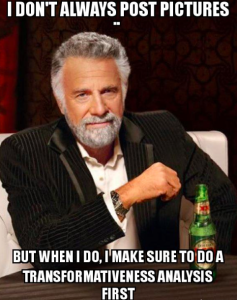Use of Iconic 9-11 Photo in TV Show’s Facebook Stream Not Fair Use
Plaintiff owns an iconic 9-11 photo. 
Defendants move for summary judgment on the basis of fair use. The court denies the motion.
- The purpose and character of use: The court says that defendants’ use is not fundamentally transformative. The changes to the original work were not substantial (and do not approach the extent of alterations found to be sufficient in Cariou and Blanch, two Second Circuit cases both involving artists). The court also says that it’s unlikely that the use contributed original ideas, insights or understandings. (The mash-up in question was sourced from the internet, rather than originally created. See Rebecca Tushnet’s post for qualms about the court’s transformativeness analysis, observing that “me-too” statements are not automatically not transformative.) Defendants argued that the work wasn’t commercial, but rather was aimed at “convey[ing] Fox News’ participation in the global conversation about 9/11. . .” On the other hand, there was no dispute that the image was posted to a Facebook page that was aimed at promoting one of Fox’s television shows. Ultimately, the court says that it’s unable to say the first factor weights in favor of either party.
- Nature of the work: This factor focused on whether the work was factual or creative. The court says that this favors fair use. The photographer didn’t set the stage but, instead, chanced upon a scene that ended up resulting in an iconic photo (citing Katz v. Cheveldina).
- Amount used: The court says this factor is neutral. This factor typically “weighs less” when considering a photo, and it was not clear that defendants’ “use of any less of the [photo] would have ensured its audience’s recognition of the iconic photograph.”
- Effect on the market: The last factor weighed against fair use. Plaintiff had an active licensing program for the image that raised more than $1 million in licensing revenue.
__
This reminds me a bit of Morel. The defendant is an established media entity, with a producer that had received training on fair use (but not with respect to this image). Nevertheless, a single image sourced from the wrong place and used in the social stream creates a giant headache. Perhaps this just illustrates the “photos are different” rule in action. This type of ruling is perhaps the reason why bloggers and websites are well advised to never simply search for an image and use it in a post or article.
The factual context of defendants’ use here is worth noting: defendants were joining the conversation around 9/11 taking place on social media. They even used a hashtag! If this fleeting usage does not fall under fair use, it makes me wonder about those times in my own Twitter conversations when I respond to someone with an image or a meme.
This is a plaintiff-friendly copyright ruling that goes slightly against the tide of numerous fair use defense wins from 2014. Other recent rulings in the same direction include BWP Media v. Gossip Cop (use of celebrity image on “Gossip Cop” website not amenable to dismissal on the basis of fair use) and Garner v. Higgins (use of politician’s photo on jhpolitics.com not amenable to dismissal on the basis of fair use), although both of these cases were decided at the motion to dismiss stage.
Case Citation: North Jersey Media Group Inc. v. Pirro, 13 Civ. 7153 (S.D.N.Y. Feb 10, 2015)
other coverage:
Fox hurts America yet again, losing fair use sj motion
9/11 Photos Causing Legal Trouble for Fox News, Other Media Outlets
Previous posts:
Copying Blogger’s Posts In Disciplinary Proceeding Is Fair Use–Denison v. Larkin
Fair Use Likely Protects Discussion of Blog Post and Comments
Another Blogger Wins a Fair Use Defense For a Photo–Leveyfilm v. Fox Sports
Republishing Litigation Brief Is Fair Use–White v. Westlaw
Griping Blogger Protected by Fair Use But Not Section 230–Ascend Health v. Wells
Republishing Entire Newspaper Story is Fair Use–Righthaven v. CIO